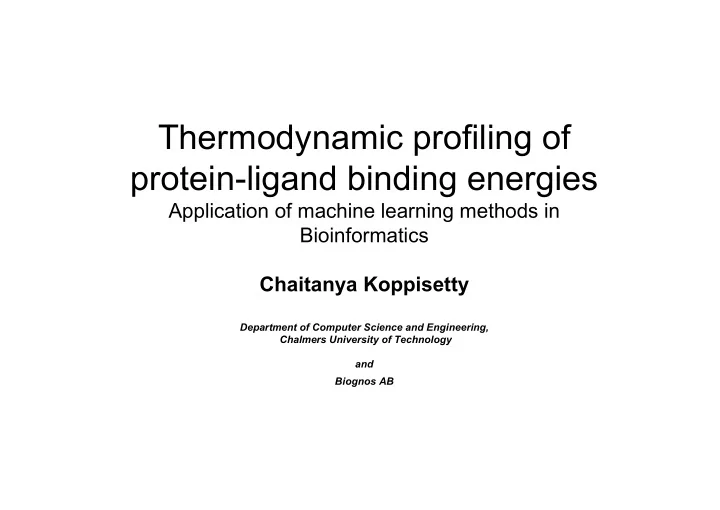

Thermodynamic profiling of protein�ligand binding energies Application of machine learning methods in Bioinformatics �������������������� ����������������������������������������������� ���������������������������������� ��� ����������
�������� • Background • Challenges • Tools / methods • Results / insights • Summary
���������� • Human body is constantly invaded by pathogens. • ”Proteins” on the surface of pathogens are vital in adhesion and proliferation.
���������� ��� �������#������� �������� ������!" ����&''���������(������(��������'������������'�������������� %������$ ����� �������������$������ ��� ����� ���������������������������������
���������� • Drugs / Inhibitors / ligands – Small molecules that prevent the adhesion or proliferation of pathogens. • ”Relenza” is the trade name for infuenza virus inhibitors (ligand) that binds to a surface protein of influenza virus that stops proliferation.
���������� Inhibitors ������(���� Receptor Host Two important properties of a drug • Affinity • Specificity
���������� Affinity – How strong does a drug bind to the target. Specificity – How specific are the drug’s interactions to that particular target • Is it binding to other proteins in the human body ? • Main cause of side�effects
���������� • Binding energy – Strength of interaction between the protein and ligand (negative value indicates binding) Binding energy ∆G = ∆ H �T ∆ S Enthalpy term Entropy term
���������� ������(���� %�������������������������������� ∆G %�������������������������������� ∆G )��������'�*�����������(����������������� )��������'�*�����������(����������������� ������������������������ ������������������������
���������� ∆G = ∆ H �T ∆ S ∆G = �10 kcal/mol Accurate estimation of ∆ H and T ∆ S is necessary for precise placement of ∆ G case
+���� Qualitative classification – Neural networks – Support vector machines Quantitative estimation – Support vector machine regression
+���� Neural networks (Multilayered perceptron) Each node/neuron in hidden layer is a non�linear activation function � � = � � − � + � � Where, y i is output of neuron i, S i is the weighted sum of all inputs and bias to neuron i Error back�propagation algorithms
+���� Support vector machines classification Hyperplane “Hyperplane” at the largest distance between border samples (“support vectors”) Support vectors
+���� Support vector machines classification
+���� SVM regression
)�������,��������� )��������'�������������(������������������ (������������������������������������ ������(���� �������-������������������ +�������������������"./��������-������� ����������� ����������������������"!//��������-������� ����������������������������������� �������� ../�)��������'������������� *������������������������0���������(����� ������������������������
)�������%�������� Feature selection / elimination • Feature reduction using Principal Component Analysis (PCA) – Reduce the dimensionality of the data by fewer samples but still preserving the variance • Backward feature elimination (BFE) Cross validation – 2 fold Cross validation – Leave�one�out Cross validation – N�fold Stratified sampling cross validation
Results Classification
Confusion matrix %������&�1��������
Results Classification
Results – SVR prediction models +��������������� +����������������� • Kernel and Hyper �parameters • Cross validation methods • Outlier analysis
Results – SVR prediction models ������������������ • Outlier analysis • Correlation coefficient and • Standard error
Application of SVR to real data • Kernel choice and parameters • Linear • Polynomial (degree) • Gaussian (width parameter) • Hyper�parameters •Parameter C •Parameter ε 2���������������#������(�������-�������������������������� • Data Normalization (?)
Summary +�������������������"./��������-�����������������3�../�)��������'� ������������ ����������������������"!//��������-������������������ SVM regression models MLP�NN and SVM Classifiers
Thanks for listening !
Recommend
More recommend